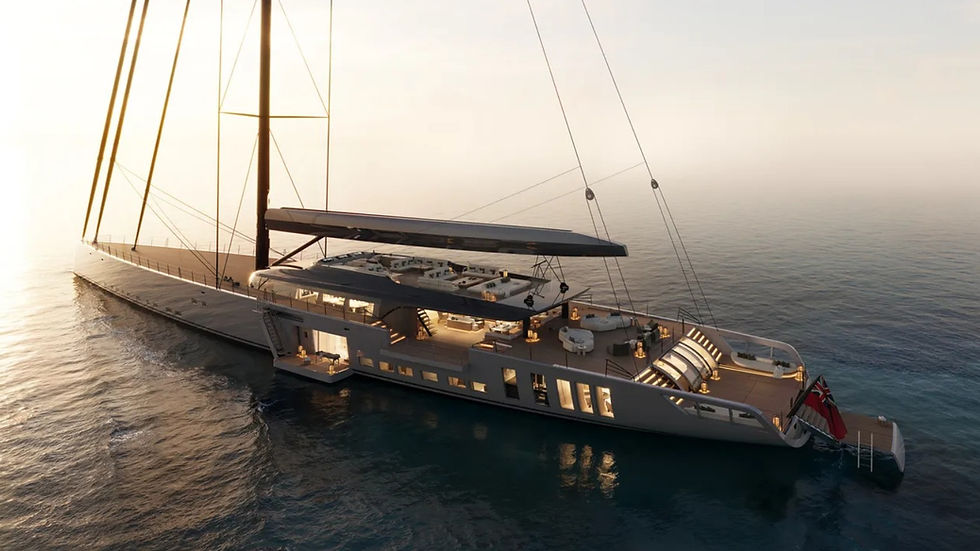Made in Canada - Some of the Best Ideas in Boating Today are Coming from Canadian Start-ups
- Craig Ritchie

- Feb 8, 2023
- 5 min read
Updated: Apr 20, 2023

We Canadians are a crafty lot, which might explain our penchant for inventing really cool things.
That includes useful goodies like the screw propeller (in 1833), standard time (1878), the AM radio (in 1906), the zipper (1913), the paint roller (1940), the pacemaker (1949), alkaline batteries (1954), the first internet search engine (named Archie, in 1988), and the world’s first smartphone – the Blackberry – in 1999.
As far as boating is concerned, we're also responsible for the first practical hydrofoil boat (1908), and the invention of sonar (1912).
So yeah, we’re pretty creative.
Boaters will be happy to know that our proud heritage of innovation lives on among Canadian start-ups in the recreational boating industry, who continue to come up with truly brilliant ideas.
Here are a couple of new Canadian nameplates that are making waves on the water.

BRNKL
Victoria, BC
Brandon Wright launched Victoria, Canada-based BRNKL (pronounced “barnacle”) after his sailboat broke free of its mooring in a 2017 storm and was nearly wrecked on an adjacent beach. Leveraging a deep understanding of IoT, remote surveillance, and electrical engineering, Wright developed his BRNKL monitoring and security system.
The platform can monitor boat location, pitch angle and heel angle, along with elements like cabin humidity, cabin temperature, barometric pressure, battery voltage, and both bilge pump and ignition switch activity. It communicates over a global 5G, LTE-M, NB-IoT, and 2G cellular network using a built-in SIM card.
With that kind of muscle, BRNKL quickly caught on with boaters on the left coast and has begun to gain users all around the world.
Its unique features, including remote camera operation to take pictures in real time during alert events, even saw the app adopted by the Canadian Coast Guard as a means of remotely monitoring derelict and abandoned vessels. By being able to continually monitor so-called ‘vessels of concern’ the Coast Guard has been able to reduce incidences of fuel spills on rivers and oceans by responding proactively before these wrecks sink or break moorage in inclement weather.
In 2022, BRNKL received a Safeguarding the Environment award from the Canadian Safe Boating Council, and was named Technology Company of the Year as part of the 2022 Grant Thornton Business Excellence Awards.

Taiga Motors
Montreal, Quebec
Montreal-based Taiga Motors introduced its Orca fully electric personal watercraft in 2019. The Orca PWC features a full carbon-fibre hull construction and a floating seat made possible by the absence of that traditional internal combustion engine. Weighing only about 270 kg and able to generate the equivalent output of a 160 horsepower gas engine, the Orca is said to offer an unrivaled power-to-weight ratio in a compact hull form that serves to differentiate it from competing high-power personal watercraft. Top speed is said to be over 100 km/hr.
The company says its 23 kW battery can deliver two hours of driving time under typical use, and recharge in 14 hours with a level 1 charger or 3.5 hours with a level 2 charger.
Taiga Motors went public in 2021, and received a $50 million investment from the federal government toward building a new battery plant in Quebec. Taiga began shipping its first Orca all-electric PWCs in July 2022, and just unveiled their new Orca Carbon at the Toronto Boat Show in January.

Voltari Marine Electric
Merrickville, Ontario
Formed in 2021, Voltari made major headlines last month when its stunning Voltari 260 center console completed the lumpy, 146-kilometer open water crossing from Key Largo in Florida to Bimini in the Bahamas, marking what the company says is the longest overseas trip taken yet in a fully electric boat.
The handmade, carbon fibre Voltari 260 is definitely an eyeball grabber, with its aggressive deep-V hull, open bow, aft center console, arched hardtop on sweeping supports, and extended stern swim platform. It comes with a big 142 kWh lithium-ion battery pack and a high performance 544 kW propulsion system developed by LTS Marine – equivalent to about 740 horsepower – that gives it a top speed in the range of 100 km/hr. Being fully electric, it whips by silently, and with zero emissions.
Well, silently until you hit the premium Rockford Fosgate stereo, which is tied into the boat’s Lumitec lighting package. But I digress.
Onboard, the enormous glass helm integrates with Garmin’s ActiveCaptain platform to deliver performance readouts, system stats, safety alerts, navigation, trip planning, range, stereo system and docking cameras in a single, easy-to-use interface.
With its all-electric propulsion system, CEO Cam Heaps notes that the Voltari 260 is virtually maintenance-free, with its water-cooled propulsion system backed by a 10 year warranty.

VoltSafe
Vancouver, BC
Based in the Coal Harbour district of Vancouver, VoltSafe has developed a high voltage shore power system that uses a flat magnetic connection instead of the traditional three-pronged plug, a design that it says is far safer because it eliminates any potential for arcing and fires caused by corrosion.
Inspired by the magnetic power cord connection of Apple Macintosh laptops, the VoltSafe design can accommodate high enough voltage to provide 50 amp or even 100 shore power service, or recharge the batteries in electric boats.
Unique internal circuitry prevents power from flowing until the terminal recognizes an exact electrical signature from its matching pedestal – a process that takes place in less than five milliseconds once the two sides make physical contact. The benefit, according to VoltSafe CEO Trevor Burgess, is an enhanced level of safety. “If you drop the plug in the water, you’re not going to pop all your breakers or electrocute anyone,” he says.
Now protected by eight separate patents, VoltSafe has patent approvals pending in another 40 different countries around the world.
Fresh from winning two Innovation Awards at the 2023 CES show in Las Vegas, VoltSafe is now looking for partners to help bring its shore power system to market.

Wavve Boating
Kingston, Ontario
In 2017, engineer and lifelong boater Adam Allore was navigating a section of the St. Lawrence River on his way to a barbecue when he had an epiphany. Navigating using paper charts with outdated data and Google Maps on his smartphone to keep track of his actual location, he decided there just had to be a better way to get around on the water.
Putting his engineering background to use, he developed the Wavve Boating app that blends current navigation chart data with user-input content to warn other boaters of potential hazards to navigation. The ability of users to add real-time updates and points of interest – similar to the way driving apps like Waze allow motorists to input traffic or accident advisories – gives Wavve Boating a unique level of accuracy and usability.
At last count, the app – with coverage for all of Canada, the US and parts of the Caribbean – had more than 32,000 points of interest with more added daily.
Additional features allow boaters to input data on their own boat’s draft so shallow spots are highlighted in red. In coastal waters, it even incorporates current tide levels.
Available for iOS and Android devices, boaters can try Wavve Boating for 14 days at no cost. After that, subscriptions cost $35.99 per year or $5.99 per month.


















Comments